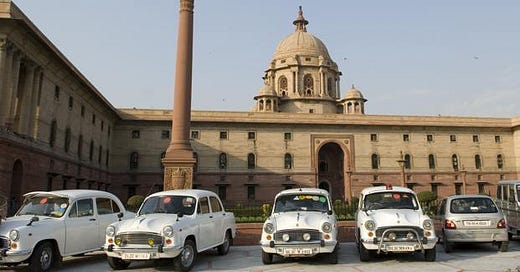Babu-mukt Bharat: Government of India Ministries sans IAS Officers
End of the IAS dominance in Central Ministries? Having a relook at the scenario since April, 2019.
Prologue:
In April 2019, the Government of India had introduced the groundbreaking "Lateral Entry Scheme" aimed at infusing new talent and expertise into its bureaucratic ranks, at the Joint Secretary and Director levels. The scheme allowed for the appointment of accomplished professionals from outside the government to serve as Joint Secretary-level officers, on contractual basis for a tenure of 3 years, that was extendable up to 5 years. While it sparked debates and discussions across the nation, it was undeniably a bold step towards modernizing and revamping the bureaucratic landscape. The Cassandras predicted the end of the IAS as we have known it, while others merely shrugged it off saying that the steel-frame, though rusted, could not be dented by such minor “aberrations”.
More than three years down the line, let’s review what the things are looking like, since the inception of the scheme. But first, let’s peruse my article (unedited and revised), as it was published in April, 2019.
=====================================================================
Babu-mukt Bharat: Government of India Ministries sans IAS Officers
End of the IAS dominance in Central Ministries?
Earlier this week, the Central Government announced the names of nine private sector professionals who had been selected to be appointed as Joint Secretaries in various Departments/ Ministries, under what has popularly been described as the “Lateral Entry” Scheme. These had been selected from amongst 6077 applicants who had applied for by the July-end deadline of last year. The Economic Times reacted with a news item[1] on 13th April, 2019, spicily captioned as “Babu-mukt Bharat”.
It was argued that this was just the beginning of a reform process with far-reaching implications and apart from loosening the near monopoly stranglehold of the career civil servants on the crucial posts in the Central Government Ministries, could perhaps also be the beginning of the end of IAS-Babudom as well know it. In May-June last year, when this initiative had been announced, tremors had radiated across of the rank and file of not only the IAS but also other services that were beginning to claim an increasing share in the Additional- and Joint Secretary level posts at the centre.
“Lateral Entry” is no threat to the IAS
I had then published an article[2] on 12th June, 2018 arguing that “it is not lateral recruitment but ‘back-door entry’ of retired ‘babus’ that can cause real damage to the IAS.” The thrust of the argument was that the IAS is here to stay because it suits the political executive and minor tinkering with the system shall not lead to the dismantling of the steel-frame. While I essentially stick to my views expressed therein, it is perhaps time to examine whether an IAS-free[3] bureaucracy is possible at the national level and also try and envision the type of stresses it shall generate in the system of governance and policy-making of the Central Government. As a caveat, may I clarify in advance that I am not advocating that this scenario would be more efficient or effective, but just penning its likely implications, if this reform is pushed through as an ideological-cum-policy initiative from the very top.
IAS is not necessarily Cat’s Whisker
I would, however, before I venture further, leave the reader to peruse two of articles that I published in 2018 on this subject. The first one argues that with the increasing resource crunch and stress on the IAS, the service is now devoting disproportionate time and resources to VVIP clients[4]. This created quite a furore amongst serving as well as retired civil servants. The second one[5] essentially encapsulated the response of the IAS as a service, claiming to be “Specialists in Generalism”, in response to the increasing demand for subject specialists in the corridors of power.
Replacing IAS with professionals on contract
With this rather comprehensive backdrop, let’s fast-forward to a scenario where bulk of the Joint Secretaries as well as Additional Secretaries, and eventually even the Secretaries, in the Ministries of the Government of India comprise “specialist” selected from top-notch professionals from the private as well as public sector, serving on fixed-tenure, contractual basis. It would seem that these “civil service professionals” would be free from any historical baggage of their cadre and seniority/ batch and deal with the issues in a a purely objective and professional manner, free from the prejudices that jaundice the views of IAS officers. However, we need to delve a little deeper lest we reach an almost naïve conclusion that this new setup is really the utopian solution that this country always needed.
Telescopic view of the specialists
As we are well aware, policy as well as complex administrative issues cut across multiple sectors that require multi-, inter- and even intra-disciplinary approaches to arrive at optimal solutions. While each “subject-specialist” would try and maximize the parameters that he regards as essential and overriding from his telescopic perspective, the other stakeholders shall feel cheated or short-changed. In short, the proposed policies would not be acceptable to the other clients or would be so impractical that these would meet considerable resistance that the implementation level, even if these are got approved with political clout.
Disconnect from the grassroots scenario
Moreover, these “civil service professionals” would barely have any clue regarding the scenario at the grassroots level, which these policies would surely impact and also be implemented in. They, being totally devoid of the experience and insights gained by the IAS officers on account of their rich and varied flied experience, would not be able to fully visualize the conditions and constraints at the cutting-edge level, leaving them to bemoan their failed policies as being “superb that were sabotaged by poor implementation”.
Resolving conflicting demands
The “new civil service” would be totally lacking in the cadre and batch networks that are often used to expedite as well as resolve critical issues by the IAS officers. Even in the inter-ministerial discussions, the pecking order of seniority would be conspicuous by its absence and cantankerous difference of opinion would frequently crop-up, that would not be resolvable at the bureaucratic level. That would send up more issues to the political executive to sort out, depriving it of its valuable time which ought to be devoted to other priority areas.
Conclusion
In summary, it is not too difficult to visualize and propose a “Babu-mukt” Bharat within the Government of India but if this so-called reform is adopted and implemented thoughtlessly, as a pre-conceived attempt to completely ease out the IAS from its Delhi perch, it could very well create more problems than it actually solves. It may well be like, as the idiom goes, “throwing the baby with the bathwater”.
======================================================================
Epilogue
Since its introduction in 2019, Government of India’s"Lateral Entry Scheme" has been closely observed in the bureaucratic landscape. With 37 lateral entrants inducted into senior positions at Joint Secretary and Director levels, the scheme had initially sparked discussions about its potential to break the bureaucratic steel-frame and usher in new talent.
However, as time passed, it became evident that the scheme's impact might not be as transformative as some had anticipated. While it opened up avenues for talented individuals from diverse fields to serve their country, it did not significantly dismantle the established bureaucratic order in the Central Government ministries.
Limited Impact: Indeed, after the initial tremors, the bureaucratic machinery seemed to revert to its traditional ways, with the “Lateral Entry Scheme” being, for the most part, a small blip in the larger scheme of things. Though it may have caused a slight dent in the IAS's monopoly in the central ministries, this influence was already being challenged by other All-India Services and Central Services.
Furthermore, concerns about the scheme's success have persisted. While some continue to laud its potential to infuse fresh ideas and expertise into the government, others remain apprehensive about the sense of insecurity it has sparked among existing officers. The clash of cultures between new entrants and the traditional bureaucracy has not been entirely resolved. It is worth noting that three of the lateral entrants chose to resign prematurely, indicating that the path to effective integration and transformation might not be as smooth as initially envisioned.
Despite the initial excitement and even apprehension, the “Lateral Entry Scheme” has not brought about a sweeping revolution in the Central Government ministries. Rather, it serves as an important indicator of the political executive's mindset, showing a willingness to consider alternative approaches to governance.
Summing up: The “Lateral Entry Scheme” has proven to be more than a mere cosmetic change, yet its impact on the bureaucratic steel-frame has been somewhat limited. As the scheme continues to evolve, it is crucial for policymakers to subject it to ongoing scrutiny and make thoughtful adjustments to ensure its success in ushering in a more efficient and progressive India. The road ahead remains uncertain, but the scheme's potential to reshape the dynamics of governance is a prospect that still warrants close observation.
But for now it seems “the more the things change, the more they are the same.”
______________________________________________________________
[1] https://economictimes.indiatimes.com/news/et-explains/babu-mukt-bharat-9-names-will-test-one-of-narendra-modis-biggest-reform/articleshow/68862140.cms
[2] https://theprint.in/opinion/ias-is-here-to-stay-because-it-suits-the-political-executive/69442/
[3] The term IAS has been used in the widest connotation here, to include other All India- and Central Services.
[4] https://theprint.in/opinion/ias-has-now-become-a-customer-service-pleasing-politicians-and-businessmen/111677/
[5] https://medium.com/@kbssidhu1961/ias-the-specialists-in-generalism-d09c64afd366







The last batch of ICS was 1942. Nirmal Mukerji of Punjab cadre was the last and he retired as Cabinet Secretary. Between 1942 and 1948, there was no recruitment through competition. There was lateral recruitment to the IAS in 1947. I know three officers of Punjab cadre, RIN Malhotra who was Deputy Commissioner, Ferozepore when I was posted there in April 1956 and Rajinder Singh who retired as Chief Secretary, Punjab and SS Grewal who too retired as Cabinet Secretary. Another officer I know was SG Bose Mullik who was DC Delhi when I went on deputation to the Delhi Administration in October, 1961. He later became the second Vice Chairman of Delhi Development Authority. They were really stalwarts. At present, lateral appointments are only in the central government. The States have their full cadre of the IAS. The country will not be Babu
Mukt😀
Agree entirely with Mr. Gupta , Mr. Singal and you . As a layman, purely an observation , no data to prove my point. The education and experience level of IAS aspirants of today far exceeds the past generation of IAS ‘s thus, the future is significantly more secure and needed.